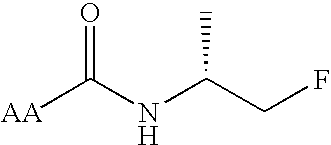Cannabimimetic lipid amides as useful medications
a lipid amide and cannabinoid technology, applied in the preparation of carboxylic acid amides, fatty acid chemical modifications, organic chemistry, etc., can solve the problems of impaired monoamine oxidase function, impaired non-receptor mediated brain function, unsatisfactory side effects, etc., to improve cb1 receptor affinity and selectivity, and metabolic stability is enhanced
- Summary
- Abstract
- Description
- Claims
- Application Information
AI Technical Summary
Benefits of technology
Problems solved by technology
Method used
Image
Examples
example 1
[0032]It is known that the enzymatic action of anandamide amidase can be moderated or prevented in vitro by the inclusion of phenylmethanesulfonyl fluoride (PMSF). PMSF functions as a nonselective protease inhibitor. Thus the ligand binding determinations for the CB1 receptor were carried out in the presence and absence of PMSF, to obtain both CB1 receptor binding affinity and a relative measure of the analog's metabolic stability. The binding affinities (Ki) are expressed in nanomoles (nM).
[0033]For the CB1 receptor binding studies, membranes were prepared from rat forebrain membranes according to the procedure of P. R. Dodd et al, A Rapid Method for Preparing Synaptosomes: Comparison with Alternative Procedures, Brain Res., 107–118 (1981). The binding of the novel analogues to the CB1 cannabinoid receptor was assessed as described in W. A. Devane et al, Determination and Characterization of a Cannabinoid Receptor in a Rat Brain, Mol. Pharmacol., 34, 605–613 (1988) and A. Charalamb...
##ic example 2
PROPHETIC EXAMPLE 2
[0042]Based on the above testing and results, it is believed that lipid compounds based on structural formulas 1 and 2, illustrated in Table 2, would exhibit increased cannabinoid receptor affinities and / or selectivities as well as increased metabolic stability. In fact, structural formulas 1 and 2 include analogs 1-12 discussed above.
[0043]
TABLE 2Structural Formula 1:
[0044]X is one of the group consisting of C═O and NH and Y is the other of that group. Expressed another way, X may be C═O and Y may be NH, or Y may be C═O and X may be NH, but both X and Y may not be the same group.
[0045]R1 is selected from the group consisting of H and alkyl groups. More specifically, R1 is selected from the group consisting of H, CH3 and (CH3)2.
[0046]R2 is selected from the group consisting of alkyl, substituted alkyl, alkenyl and alkynyl groups. More specifically, R2 is selected from the group consisting of CH(R)CH2Z, CH2CH(R)Z and CH(R)(CH2)nCH2Z, R being selected from the group...
PUM
| Property | Measurement | Unit |
|---|---|---|
| Molar density | aaaaa | aaaaa |
| Molar density | aaaaa | aaaaa |
| Molar density | aaaaa | aaaaa |
Abstract
Description
Claims
Application Information
 Login to View More
Login to View More - R&D
- Intellectual Property
- Life Sciences
- Materials
- Tech Scout
- Unparalleled Data Quality
- Higher Quality Content
- 60% Fewer Hallucinations
Browse by: Latest US Patents, China's latest patents, Technical Efficacy Thesaurus, Application Domain, Technology Topic, Popular Technical Reports.
© 2025 PatSnap. All rights reserved.Legal|Privacy policy|Modern Slavery Act Transparency Statement|Sitemap|About US| Contact US: help@patsnap.com



